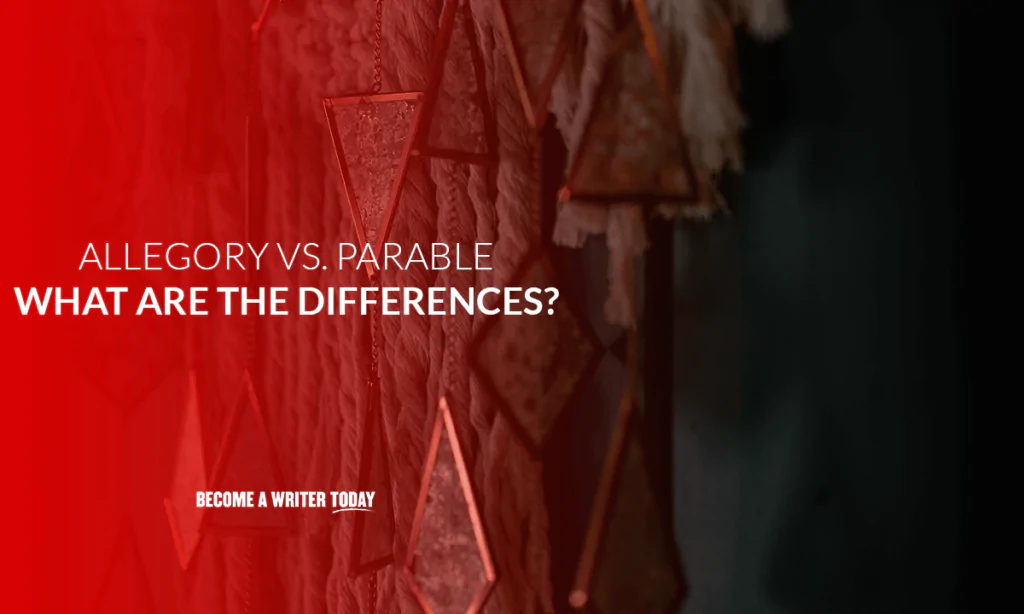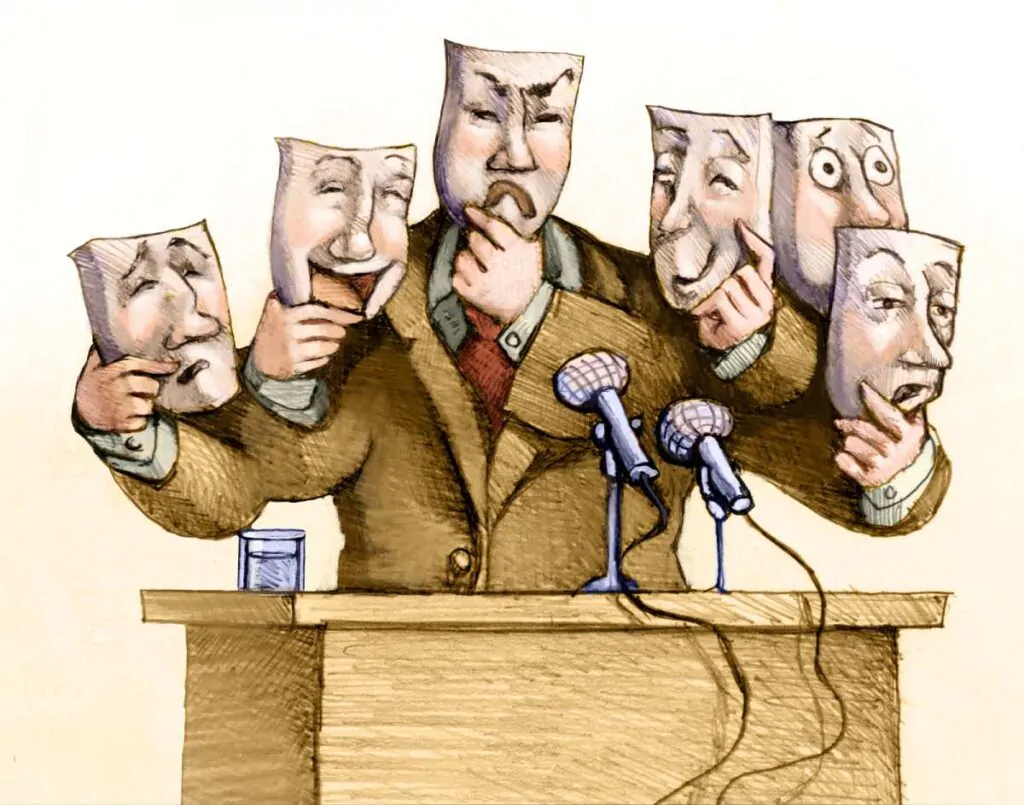Check out our guide to learn the difference between an allegory vs parable. Both linguistic tools convey important messages.
There are a lot of stylistic devices used in literature, and two examples are allegories and parables. Both tools help someone present important messages or key lessons; they are linguistic tools. Even though many people believe an allegory and a parable are the same, there are some significant differences.
An allegory is an image, poem, or story whose interpretation can communicate a hidden meaning. In contrast, a parable is a simple story illustrating moral or spiritual lessons. What are a few examples of allegories and parables in literature?
Living Writer contains time-saving templates for authors and novelists. iOS and Android apps available
Contents
What Is an Allegory?

Allegories are specific works that can be interpreted to have a hidden meaning. They commonly show up in images, poems, and stories. Allegories often communicate political or moral messages upon deeper analysis. With an in-depth interpretation of a story, a concealed lesson may appear.
How to Identify an Allegory
There are several common characteristics of allegories. These include:
- It’s a short story or prose that can be read symbolically.
- Religious writers often use allegories to teach principles of faith.
- Ethical writers commonly use allegories to communicate certain morals.
- Satirists can use allegories to communicate political or social messages.
Examples of Allegory

Examples of allegory include stories, poems, or other literary works that communicate a hidden message. Often, these messages are used to show the author’s political, social, or moral commentary. Here are some of the most famous allegory examples:
Animal Farm by George Orwell
Animal Farm is one of the most famous examples of allegory. In this story, it appears that farm animals are rebelling against the farmer. However, the true meaning reflects on Orwell’s disappointment with the Bolshevik Revolution and critiques the Russian government.
No products found.
The Allegory of the Cave by Plato
Allegory is common in philosophy, and one classic example of this is Plato’s The Allegory of the Cave. In this allegory, a group of people spend their lives in a cave and p[perceive the outside world based on the shadows on the cave walls. The allegory aims to reflect on the limitations of human understanding.
- Plato (Author)
- English (Publication Language)
- 25 Pages - 07/07/2017 (Publication Date) - Independently published (Publisher)
The Tortoise and the Hare by Aesop
Aesop’s gables are mainly allegorical, and The Tortoise and The Hare is arguably the most famous. The story follows a tortoise’s victory over an arrogant hare, and the moral lesson is to show the value of perseverance over recklessness. The story has been retold and adapted throughout history for children’s stories.
No products found.
What Is a Parable?
A parable is a simple story used to teach spiritual or moral lessons. This literary device is common in religious texts like the Bible. The Bible has many Gospels with hidden spiritual lessons known as parables.
How to Identify a Parable
There are a few key characteristics of a parable that set it apart from an allegory. The key differences to look out for include:
- It’s short, with a simple narrative.
- It illustrates a spiritual or moral lesson.
- It involves a character facing a moral dilemma or one who has made a bad decision and is suffering the consequences.
- It expresses an abstract point of view using argument and narrative.
Examples of Parable
Most examples of parables appear in religious texts, like The Bible. Some of the most famous parable examples can be found in the Old and New Testaments of the Bible, where the story is used to illustrate moral lessons. Here are some examples taken from The Bible:
The Poor Man’s Ewe Lamb
This narrative follows Nathan, who confronts Kind David with a tale of a rich and poor man. The parable is about a rich man who takes a poor man’s lamb instead of using his own. This parable shows King David how he is abusing his power by sleeping with one of his soldier’s wives.
The Good Samaritan
This parable is shared by Jesus in Luke 10:30-37. In this narrative, a Jewish traveler is attacked and left for dead. While most people ignore him, a Samaritan helps him, despite the tensions between Jews and Samaritans at the time. The moral of the story is to show love to everyone, even if they are your enemy. The term “Good Samaritain” is now used to describe a person who helps others.
The Prodigal Son
This parable involves a man with two sons. The youngest son asks for his inheritance and wastes it, becoming destitute. He then returns to his father and asks to work as a servant. The older brother shuns the younger son, but the father forgives the younger son and welcomes him back with open arms. The father’s love redeems the Prodigal Son.
The Differences Between Allegories and Parables
- An allegory is a broad literary device. It is used as a metaphor and conveys a broader message about morals. A parable is shorter, brief, and direct. The meaning of a parable is not hidden.
- An allegory commonly uses the forces of nature, inanimate objects, plants, and characters to tell a story. In contrast, human characters directly communicate the moral lesson in a parable.
- Parables are usually closely associated with religious works. Allegories are not necessarily limited to religion.
Final Word on Allegory vs. Parable
Both allegories and parables are powerful literary devices conveying important messages or lessons. Although they are often confused, they have some distinct differences. Allegories are more metaphorical and often involve characters representing abstract ideas, and the symbolism can be deeply complex. However, parables are more direct, with a simple narrative that usually involves a human character facing a moral dilemma or the consequences of a bad decision.
While allegories can convey various messages, they are usually associated with political or moral issues. On the other hand, parables are commonly found in religious works and are used to convey spiritual or moral teachings.
Both allegories and parables have stood the test of time and continue to influence readers to this day. These literary tools can be used in writing to enhance symbolism and influence readers to live more ethically.
FAQs About Allegory Vs Parable
What is the difference between a parable and a fable?
Parables are distinct, didactic stories that use human characters to communicate important moral lessons. In contrast, a fable, such as Aesop’s Fables, employ inanimate things, plants, animals, and forces of nature as characters.
Are The Parables of Jesus allegories?
Many medieval writers interpreted The Parables of Jesus as allegories. There were important symbolic correspondences in each element of his parables. Today, most of Jesus’s parables are intended to make a single important moral point. Therefore, they are usually considered parables instead of allegories in the modern era.
Looking for more? Check out our guide on paraphrasing vs quoting!
